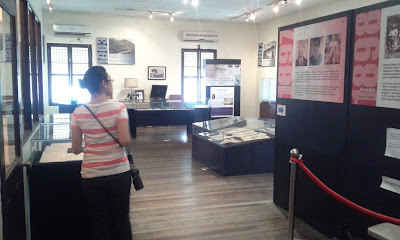If you are visiting Cebu City you could immerse yourself in its rich historical origins with the bits and pieces of information at the Museo Sugbu. It is basically a pre-colonial and colonial Cebu on display at the Museum. Relics of Cebu’s past from archeological discoveries as well as donated items by donors who survived through the wars (or their heirs) will take you back in time. The Museum features priceless pre-colonial and colonial (Spanish, Japanese, American) artifacts. You could also view a video narrative summarizing Cebu’s ancient origin at the pre-colonial display section.
What’s more, the museum is housed in what used to be Carcel de Cebu, a provincial jail built in 1869. It was later changed to Cebu Provincial Detention and Rehabilitation Center (CPDRC). Consider yourself in double treats as you go inside the museum because the facility, though, renovated still distinctly retain the actual structures of the old jailhouse. As you transfer from one museum display area (jail section) to another you could curiously imagine how prison life could have been at the time. You could be left eerily in awe as you scan the vicinity. Let everything else speak for itself in your experience when you get there.
To get there cheaply you can take the jeepney ride bearing the route codes 03L, 03B, 03A, 21A, 21B, 21D, 10k or you can simply ask sidewalk vendors in the downtown area which jeepney route to take to get you to either M.J. Cuenco Ave. , Tejero, or Martires street where the museum is located.
Entrance Fees at the Museo Sugbu as of this post are:
Students: Php10 (Filipinos), Php50 (Balikbayans), Php50 (Foreigners)
Adults: P30 (Filipinos), P75 (Balikbayans), P75 (Foriegners)
Senior Citizens: Php10 and Free Admission for ICOM (International Council of Museums) members.
Now, let's take a look at some of my humble snapshots taken from this poor man's smart phone camera:

The Museo Sugbu housed by the old Cebu Provincial Detention and Rehabilitation Center (CPDRC). It is also the colonial Carcel de Cebu, also a jail house during the Spanish colonization.

Archeological artifacts of Cebu's antiquitity at the pre-colonial section of the museum.

Spanish colonization era's relics of governance on display at the Spanish gallery. Here, you can see numerous preserved personal and public documents of Cebu's government during the time.

The upper gallery of Spanish and American colonization era. At the far, opposite side of the room are housed the era of Japanese-American heirloom.

The media gallery showcasing the gadgets and equipments used by the press people during the post american era.

It was already getting time for lunch when my niece and I were about to leave thinking we have seen everything at the museum. While snapping photos a few last time, Nikki discovered one more gallery located in an inconspicuous area of the jail. I was so amazed with our last-ditch museum finds of an array of vintage bikes on display courtesy of the Vintage Bike Club of Cebu.
While these photos should give you glimpses of the Museo Sugbu briefly highlighting Cebu's pre-colonial and colonial history an actual view should not substitute any of the best photograph anyone can take. At least, those humble photos serve another purpose, that is, make you crave for so much better, actual views of the museum if you happen to visit Cebu City.








